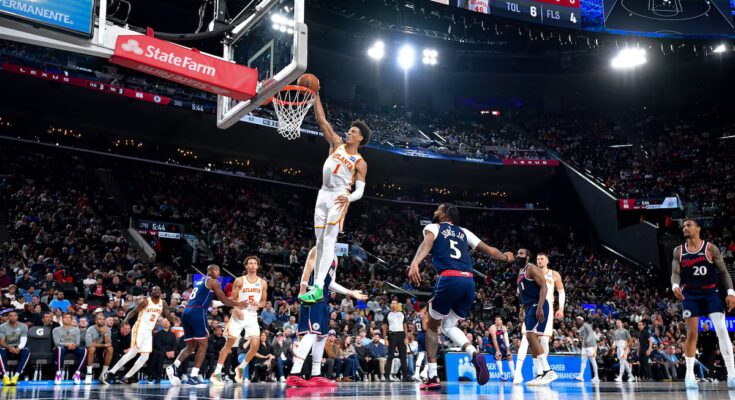Changes in television consumption habits are a reality. Streaming platforms, those that offer audiovisual content on demand on the internet (OTT, in the jargon of the sector), have more and more weight in homes: in Spain alone, 63% had contracted a paid platform at the end of 2024, when four years earlier they did not reach half, according to data from the National Markets and Competition Commission (CNMC).
A boom that is transferred to one of the contents most requested by the public: sport, of growing interest for platforms as a tool for building subscription loyalty. These will constitute, at the end of this year, 20% of global spending on sports audiovisual rights, or 10.8 billion euros, according to a report by the investment bank Houlihan Lokey to which this newspaper had access. That 20% is the highest share of spending that these types of platforms have achieved to date within the global sports landscape, with an increase that has accelerated over the last five years. In 2021 these represented just 8% of the total, multiplying their investments by more than four.
The most relevant in this area are Dazn, specialized in sports content; Amazon Prime Video, which just launched a multimillion-dollar alliance with the NBA globally; YouTube TV, which broadcasts the NFL in the United States; or Netflix, also an ally of the NFL or which secured, for a 10-year period, the broadcast of WWE wrestling in a deal valued at $5 billion.
All this in a growing market context. Houlihan Lokey estimates that total spending on sports rights for this year will be 56.6 billion dollars, around 48.8 billion euros at current exchange rates, 9.5% less than the previous year due to the absence of major sporting events, while in 2024, for example, the European Football Championships or the Paris Olympics will be held.
For Juan Luis Muñoz, mergers and acquisitions partner at Houlihan Lokey, both competitions marked a turning point. “Platforms compete fiercely for premium content and this is redefining the map of audiovisual investments in Europe. Audiovisual rights have become a strategic asset for funds, broadcasters and technology platforms alike,” he adds.
The trend will change in 2026. The report attributes a value of 66.6 billion dollars to audiovisual rights, approximately 57.4 billion euros, which will represent a new record, “driven by the expansion of global audiences, the adoption of streaming, major global events and historic agreements in major sports, both established and emerging”, underlines the report.
The latest rights renewals confirm this line: the NBA doubled its revenues after the alliance with Amazon globally, and ESPN, ABC and NBC in the United States. The UFC, a mixed martial arts competition, will multiply it by four thanks to the new agreement signed with Paramount, which will come into force in 2026. Or the WNBA, the US women’s basketball league, which will go from 50 million dollars to 200 million from next year.
Women’s sport appears to be one of the main drivers of growth in the value of sports rights. For Carlos Parames, also an associate of Houlihan Lokey, “the rise of women’s sports is not just a temporary trend, but a structural change in the entertainment economy.” In his opinion, “professionalisation, the improvement of audiovisual production and the interest of brands have transformed this segment into one of the most dynamic and profitable on the market”. This year, women’s sport will reach a total turnover of 2.4 billion dollars, approximately 2.07 billion euros. Since 2022 they have multiplied by more than three. Of this amount, 25% corresponds to audiovisual rights and the majority, 54%, to commercial or advertising agreements.
The most valuable competitions
Globally, the ranking of sports competitions that generate the most money from the sale of their sports rights is dominated, in three of the top four positions, by American championships. With data from 2024, the NFL is in the lead with over 12,000 million euros, followed by the English Premier League, with almost 4,000, and the NBA and the baseball league. After them, the UEFA club competitions and the Paris 2024 Games, followed, in seventh place, by the Spanish football championship, with a value of its rights of around 1.9 billion euros.
Precisely, LaLiga has just launched the tender for the rights to the First Division in Spain for a period of up to five years, starting from the 2027/2028 season, despite still having more than a season and a half remaining on the current contract, in an attempt to exploit the current traction of the audiovisual market and, perhaps, attract platforms that offer more.
The last match was already a novelty, awarding Dazn five matches in 35 of the 38 days of competition, and the rest to Telefónica. The current one started on November 7 and the receipt of offers will last until the 28th of this month. As a novelty, LaLiga has structured six lots, including one that would allow the successful bidder to broadcast nine matches a day, exclusively, and all matches between Real Madrid, Barcelona and Atlético. We will have to wait until mid-December to see if LaLiga scores a goal and improves its domestic revenue.



